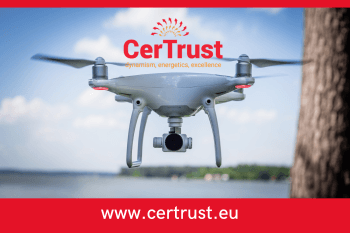Despite their current popularity, the origins of drones date back to 1898 when the great inventor, engineer, and physicist Nikola Tesla came up with the idea of unmanned aircraft. Tesla’s goal was to decrease the number of casualties among pilots and create a faster means of messaging.
The term UAV comes from the abbreviation of Unmanned Aerial Vehicle, while UAS refers to Unmanned Aerial System, a definition emphasizing that these aircraft do not require a pilot on board. RPA(S), on the other hand, stands for Remotely Piloted Aircraft (System). This definition refers to a pilot remotely controlling the device.
The classifications of drones
Drones can be classified according to their motors, type, and the number of engines that power them. As for the motors, two basic types exist: brushless and brush/ed, where brushless means “without brushes” and brush/ed “with a brush”.
Brush/ed motors
These were built into drones for personal and commercial use. These motors are cheaper than their brushless counterparts. However, they require ongoing maintenance. The size of these motors differ, but their performance is practically the same regardless of the type.
These motors allow for a maximum speed of 50-70 kilometers per hour, while they usually do not come into contact with the propeller. Instead, the motor is driven by a large gear which in turn is driven by a smaller gear. Such a system is called a “reducer” because the combination of these two stages allows the engine’s maximum power to be reduced.
This reduction plays a key role: when supplying crews or performing maneuvers, the engine speed must be controlled, so that movements remain smooth and masterful. It also extends the lifespan of the engine.
Brushless motors
Unlike brush/ed motors, brushless motors do not have brushes. Since the brush does not come into contact with the rector, this motor requires minimal maintenance, while its operation is efficient and effective.
Another characteristic that distinguishes brushless motors from brush/ed motors is the power they can deliver. Brushless motors can reach a speed of up to 150-200 kilometers per hour.
However, most brushless motors run on alternating current, meaning that every model must have an ESC, or electronic speed controller, responsible for determining the speed.
When choosing the drone you need, consider its application, as well as your own piloting skills. Beginners might buy a drone with a brush/ed type of motor, as they are cheaper and less difficult to manage.
Types of drones according to their arm number
Drones can also be classified based on the number of arms. If, for example, the drone is a brushless type, each arm will have one or more motors and their associated gearboxes.
Tricopter
This type of drone has three arms, as the name suggests. Tricopters usually have three motors with their associated three gearboxes, a servo motor, and four propellers. This arrangement allows the drone to achieve better stability and fly smoothly.
Quadcopter
Quadcopter drones are the most commercialized drone type. They are popular due to their physical construction as the easiest and cheapest type of drone commercially available. They can be recommended for those who want to learn how to operate unmanned aerial vehicles.
As their name suggests, quadcopter drones have four identical motors and four propellers, two of them in two cross positions to achieve stability of the drone.
Hexacopter
Hexacopter drones can come with a brush/ed motor, like nano or toy drones, or brushless motors seen in professional drones. In general, hexacopter drones carry a camera and gimbal for aerial photography.
Another outstanding feature of hexacopters is stability: if one of their engines fails, it will still be possible to stabilize the device with the other five engines so it can land without damage.
Is a hexacopter better than a quadcopter?
The answer depends on the type of application. A hexacopter can undoubtedly handle more force and provides superior stability compared to quadcopter drones. The same applies when comparing an octocopter to a hexacopter. The model’s flight stability improves by adding more motors and arms, but on the downside, its size will increase, and it may no longer be suitable for small places.
Octocopter
Unlike other types of drones, octocopters only come with brushless motors. They are usually sold as separate parts, requiring the user to assemble, weld, and even fully configure the drone, the command controller or emitter, and even the gimbal, if applicable.
Coaxial
The so-called coaxial drones have twice as many motors as the number of arms, which result in a different appearance than most drones. “Coaxial” refers to the two motors in their arms, the two corresponding gearboxes, and two propellers.Virtually all drones of this type are tricopters or quadcopters, although some models have more than six arms. They are used for transporting professional cameras, such as those used to record football matches. Such devices are required to be more powerful and heavier than those used for personal entertainment.
Types of drones according to their application
Starter drones
These drones function as training tools for inexperienced pilots who practice flying with these devices.
Starter drones are usually the cheapest and have high impact resistance due to their brush/ed motors, which allow for more safety and control over the drone when it is at a certain distance or altitude. Such drones are ideal for a pilot to gain experience. It is also common for beginner drones to feature flight assistance in addition to different speed settings.
Competition drones
These types of drones are, as expected, used for drone-to-drone competitions. They are made of durable yet lightweight materials such as carbon fiber. Some come with high-powered engines that speed up to 200 kilometers per hour and require a highly trained pilot.
Manipulating these drones requires cameras that transmit real-time information to the pilot. This type of camera can be an FPV which transmits the images it captures to the special goggles of the pilot. These glasses are very similar to those used in virtual reality and can even make you feel like you are flying inside a drone.
Types of camera drones
Undoubtedly, one of the most common applications of drones is aerial photography and video recording. They range from inexpensive drones with WiFi cameras to drones for professional use with high-resolution cameras and stabilizers for cinematic applications.
Types of professional drones
Professional drones are usually custom-made according to the field of use. For example, an agricultural drone will typically have a sulfur tank installed.
In these devices, even the command controller must be configured for the application so that the drone will follow the desired sequence. Professional drones typically use a brushless motor to provide more power and stability for carrying loads.
These drones certainly have high-quality cameras that capture high-resolution images and videos, often recording thermal spectra and infrared light, among other things.
Types of drones for military use
Like most technological inventions, drones had their earliest origins in military use. Military drones are known by the abbreviation UCAV or Unmanned Combat Air Vehicle. They have specific applications on the battlefield, for example, to provide air support or to carry out high-risk missions to spare human life. Due to the risk of being shot down by the enemy, these drones are made of quality materials.
Please see our related services: UNMANNED AIRCRAFT SYSTEMS


